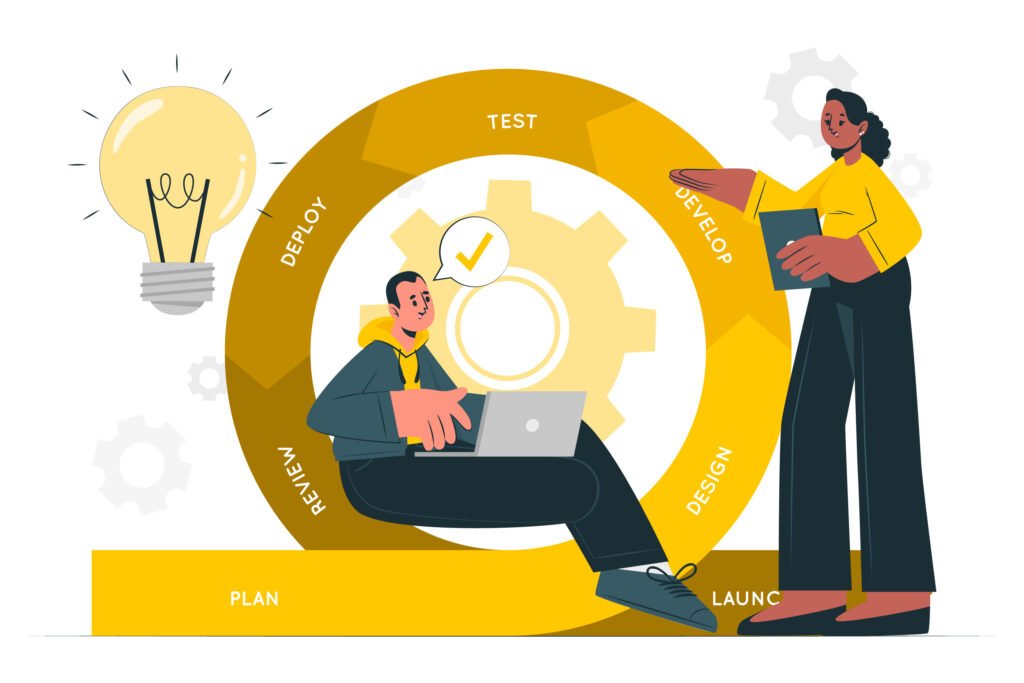Ensuring Software Excellence: Next-Gen QA Testing Strategies for Agile Development
13 Sep 2023
Ilya Lashch

Testing phase in software development is extremely important. Not surprisingly, the collaboration between development teams and Quality Assurance (QA) testing established itself as a must-haver. This synergy between creation and evaluation not only accelerates the development cycle but also ensures that the end product meets the highest standards of functionality and reliability. As organizations strive to deliver top-notch software in record time, integrating these processes has become essential.
In this article, we’ll discuss the role of parallel collaboration between software development and QA testing strategies in shaping modern software landscapes. We’ll explore how this synchronization drives efficiency, minimizes bottlenecks, and fosters a culture of continuous improvement. Join us as we navigate the evolving landscape of test automation tools and frameworks and uncover the powerful strategies that streamline the QA process.
AI-Driven Test Automation
As software applications become more complex and interdependent. With many different platforms and devices that need to be tested, it is more important than ever to have all-round QA testing strategies to ensure that the software products/systems follow the specified requirements and work successfully in all expected environments with the required usability and security.
An adequately tested software product meets the following standards:
- Optimal performance
- Security
- Longevity
- High-quality
- Flexibility
- Cost efficiency
Test engineers spend much time on manual processes in classic software tests. However, many manual testing protocols do not meet most modern demands. This is where AI comes into play. Let’s look at the comparative advantages of AI automation tools and frameworks over traditional ones.
- Enhanced test coverage and efficiency
AI-driven test automation can comprehensively cover various scenarios and functionalities, leading to higher test coverage and improved efficiency in agile development cycles. In contrast, traditional tools and frameworks in test automation often rely on predefined scripts and manual updates, whereas AI-driven approaches dynamically adapt and self-adjust.
How it works: imagine a mobile banking application undergoing agile development. Traditional testing methods might struggle to cover all possible user interactions across various devices, operating systems, and network conditions. AI-driven testing can automatically generate test cases, simultaneously simulating thousands of user journeys on different platforms. This approach ensures that critical scenarios, such as fund transfers, account creation, and payment processing, are thoroughly tested across all possible variations.
- Early flaw detection and faster feedback loop
Traditional testing tools and frameworks typically depend on predetermined test cases and manual analysis. AI-powered testing can identify defects early, allowing developers to address issues promptly and leading to a faster feedback loop in agile development.
How it works: in complex e-Commerce platform development, agile teams often face challenges identifying UI inconsistencies and functional glitches across numerous product listings. AI-driven test automation tools can rapidly scan the application’s UI elements, comparing them against functional specifications. By flagging discrepancies early, developers can swiftly make necessary adjustments, preventing defects from cascading down the pipeline and ensuring a shorter feedback loop.
- Data-driven decision-making and predictive analytics
AI-enabled testing gathers and analyzes large volumes of testing data, empowering teams to make informed decisions, identify trends, and predict potential issues in agile projects. Conversely, traditional tools and frameworks for testing rely on manual data interpretation and limited analytics, lacking AI’s sophisticated data processing capabilities and thereby restricting the depth of insights and predictive capabilities achievable in agile project environments.
How it works: consider a social media platform undergoing continuous enhancements in an agile environment. AI-driven testing employs machine learning algorithms to analyze historical user data and simulate user behavior in response to changes. This insight can help development teams identify potential bottlenecks and ensure a seamless rollout of new features while aligning with user expectations.
By leveraging the power of AI-driven testing in agile environments, software development teams can achieve greater efficiency and more informed decision-making.
Exploratory Testing in Agile
Exploratory testing adapts tests dynamically based on object knowledge, exploration, and prior test outcomes. The exploratory testing approach can be applied at any stage of development. Skilled testers explore the application ad-hoc, trying various inputs and interactions to uncover potential defects and issues that scripted testing might have missed.
How to seamlessly integrate exploratory testing into agile workflows?
Lightpoint’s QA experts developed a list of recommendations.
- Clear objectives and charted territory. Define specific testing objectives and areas of focus before starting exploratory testing. This prevents aimless wandering and ensures that you systematically cover critical functionalities.
- Document and share findings. Keep detailed notes of your exploratory testing sessions, including steps taken, observations, and any defects discovered. Sharing these findings with the development team helps resolve issues quickly.
- Time management and iterative approach. Set time limits for exploratory testing sessions to maintain focus and prevent exhaustive testing. Adopt an iterative approach — learn from each session and continue to explore areas that require attention.
Following these best practices and integrating exploratory testing in agile workflows can uncover hidden defects and enhance collaboration among team members.
Continuous Security Testing
According to a 2023 IBM study, the average cost of a data breach globally is around $4.45 million, which is a 15% increase over the last three years. This stark reality underscores why security testing frameworks are paramount in agile development. With their rapid iterations and frequent releases, agile methodologies prioritize speed and flexibility, which can inadvertently lead to security oversights if not carefully managed.

With cybersecurity threats constantly evolving, adopting security practices from the outset helps identify vulnerabilities early and reduce the potential damages that could arise from a security breach. Check out three popular continuous security testing approaches and, most importantly, how they work in practice.
- Static application security testing (SAST)
SAST involves analyzing the application’s source code to identify vulnerabilities during the development process.
How SAST combats security breaches: SAST scans the source code for insecure input validation, identifying potential code injection points. For instance, it detects unfiltered user inputs that might lead to SQL injection vulnerabilities. By finding and fixing these issues early, SAST prevents attackers from injecting malicious code into the application.
- Dynamic application security testing (DAST)
DAST involves running security tests against a running application to identify vulnerabilities from an external perspective.
How DAST combats security breaches: DAST sends malicious input to the application and observes its responses. If the application reflects the input back without proper encoding, it’s vulnerable to cross-site scripting (XSS) attacks. DAST identifies such vulnerabilities by examining the application’s output for potential injection points and helps teams fix the issues before deployment.
- Interactive application security testing (IAST)
IAST combines elements of both SAST and DAST by observing the application’s behavior during runtime and analyzing its code.
How IAST combats security breaches: IAST monitors how data is deserialized within the application. If untrusted data is not properly validated during deserialization, it can lead to security vulnerabilities. IAST identifies these weak points by tracking data flow and code execution paths, helping teams recognize and address insecure deserialization vulnerabilities.
These continuous security testing approaches are crucial in identifying vulnerabilities across the software development lifecycle. With the increase in cybercrime and awareness of the risks associated with software vulnerabilities, app security must now be designed and developed concurrently with desired business functionality. To identify and address vulnerabilities proactively, we provide custom software development services and utilize tailored security testing frameworks, so reach out for a consultation.
Shift-Left Testing Practices
Shift-left testing is one of the next-generation testing strategies. This approach speeds up software testing and facilitates development by moving the testing process earlier in the development cycle.
There are three main types of shift-left testing:
- Traditional shift-left testing emphasizes unit and integration testing alongside API testing, utilizing contemporary testing solutions.
- Incremental shift-left testing breaks down complex developments into smaller pieces so they can be tested in sequential segments. Incremental shift left testing is one of the most common methods.
- Model-based shift-left testing incorporates executable requirements, architecture, and design models to eliminate 45 to 65 percent of errors introduced in these early stages. The model-based approach is the latest trend in shift left testing.
The early bird catches the worm; the same applies to timely vulnerability assessment. Early bug detection and prevention lead to multiple benefits, as it is always cheaper to prevent a bug than to fix the consequences.
- Cost savings. Identifying and fixing bugs early in the development process reduces the cost of rectifying issues in later stages, where fixing can be significantly more expensive.
- Enhanced product quality. Early bug detection ensures a higher quality end product, improving user satisfaction and reducing post-release issues.
- Faster development cycle. Addressing bugs promptly accelerates the development cycle, enabling quicker releases and keeping projects on schedule.
Neglecting those measures can lead to delayed releases, increased development costs, and potential damage to your reputation if critical bugs emerge post-release.
Test Environment and Data Management
Ideally, the test environment is a copy of the real environment. The memory resources should correspond to the productive system. For example, if the real environment has two terabytes of storage space, the test environment should have a similar amount of space.
What could be the data management strategies for testing efficiency? Let’s look at two examples – and how they can be applied in software development for different industries.
- Test data generation and management
QA experts can generate realistic and diverse test data to simulate real-world scenarios, ensuring thorough testing coverage while maintaining data privacy and security.
How it works: in an e-commerce application, generating test data to mimic various customer profiles, purchase histories, and order quantities allows testers to simulate different user behaviors. This helps identify potential bottlenecks and issues in the checkout process, ensuring the application’s readiness for peak shopping seasons.
- Data masking and anonymization
QA experts protect sensitive data by masking or anonymizing personally identifiable information (PII) before using it in testing environments, ensuring compliance with data protection regulations.
How it works: patient medical records contain sensitive information in a healthcare software application. Using data masking, testers can replace real patient names and identification numbers with fictional ones while preserving data relationships. This enables rigorous testing without risking patient privacy breaches.

QA Metrics and Reporting
Agile project management supports real-time QA metrics and reporting, aligns outcomes with customer value, and offers real-time progress tracking. Three key aspects of agile reports encompass process insights, revealing bottlenecks, and performance clues. They’re responsible for tracking project progress against planning, measuring customer value through issue resolution efficiency, and optimizing service delivery to enhance customer satisfaction and predictive delivery.
To support the continuous improvement in QA, make sure to follow these key metrics for evaluating QA testing effectiveness:
- Defect detection rate. Measure the percentage of defects identified by QA testing compared to the total flaws in the system. This indicates how well testing is catching issues before they reach users.
- Test coverage. Calculate the percentage of the application’s functionality covered by test cases. A higher test coverage signifies a more comprehensive user-centric testing approach.
- Defect leakage. Track the number of defects found in production after release. Lower defect leakage indicates that QA testing is effectively identifying and preventing issues.
- Testing cycle time. Measure the time to complete a testing cycle, from test case creation to defect resolution. Shorter cycle times indicate faster feedback loops.
- Test automation coverage. Evaluate the percentage of test cases automated versus manual. Higher automation coverage can lead to increased efficiency and consistency.
- Mean time to detect (MTTD). Calculate the average time taken to identify defects. A lower MTTD indicates that QA testing is quickly identifying issues.
- Mean time to resolve (MTTR). Measure the average time taken to resolve defects. A lower MTTR signifies efficient defect resolution processes.
- Testing costs. Assess the cost of QA testing with the overall project budget. Effective QA should deliver value without disproportionate costs.
It’s essential to analyze these metrics to understand your testing processes’ impact on the software’s quality and drive continuous improvement. As a well-versed software testing services company, Lightpoint can plot a course toward improved testing of your organization’s processes and help you set up agile development workflows.
Collaborating QA and Development Teams
Collaborative QA and development teams offer remarkable efficiency through their synergistic efforts. By closely working together, teams swiftly identify and address issues early in the development process, preventing costly delays. This collaborative approach ensures software excellence, reducing the need for extensive rework.
Moreover, the shared understanding of project requirements achieved through collaboration enables QA testers to create targeted test scenarios aligned with user expectations. Developers, in turn, can craft code that aligns seamlessly with the application’s purpose, resulting in a product that genuinely meets user needs.
Overall, an efficient knowledge exchange empowers teams to anticipate edge cases and real-world scenarios, ultimately leading to robust, reliable software that can meet the challenges of the modern technological landscape.
The Future of QA Testing in Agile Software Development
Based on all of the above — yes, you need to focus considerably more on testing in the future, which confirms the emerging trends in QA testing, including cloud-based testing environments, integration of security testing as an integral part of QA strategies, and more. According to last year’s Business Agility Institute research, relentless improvement is one of the critical indicators of business agility. Thorough testing means higher quality — and, therefore, more sustainable business models.
If we were to imagine the world of future QA, it would look like this:
- development and testing are united
- tester, test manager, and quality manager in a team
- test is part of each iteration
- test levels are taken into account but embed themselves in another system
- test levels run in parallel
- more automated testing due to the coupling of development and testing
- point-by-point documentation
Continuous improvement in QA equals approaching the ideal agile software development process, as it means killing any possible bug on sight. Moreover, the future focus is on cross-functional agile teams holistically taking care of a value stream supported by platforms that the teams can primarily operate. Domain experts will work more closely with developers, UX designers, DevOps, and users of the products, all learning from each other.
Conclusion
In the dynamic landscape of agile development, the importance of next-gen QA testing strategies cannot be overstated. From accelerating time-to-market to enhancing customer satisfaction, these strategies form the bedrock of software excellence. Through this journey, we’ve explored how AI-driven testing optimizes efficiency, how security becomes a shield against threats, and how collaborative exploratory testing unlocks hidden insights.
As you navigate the ever-evolving realm of software, remember that innovation is your ally. By implementing these strategies, you’re not just meeting the standards of agile software delivery — you’re setting new benchmarks for excellence. Contact us to pave the way for software that truly stands out in the crowd.


